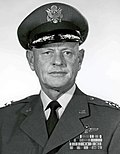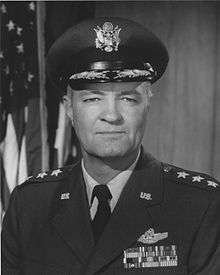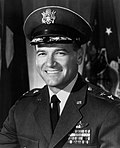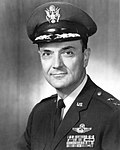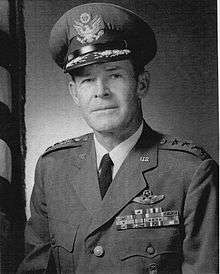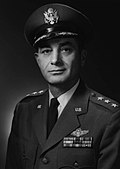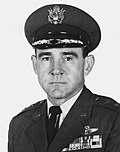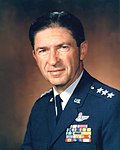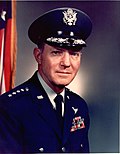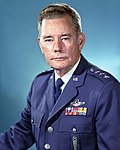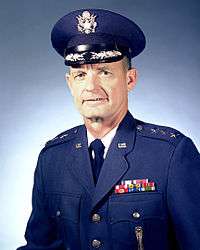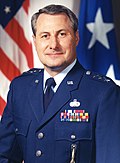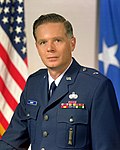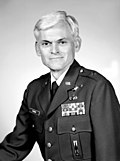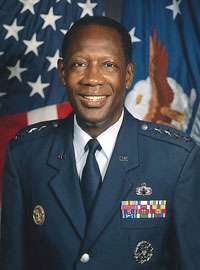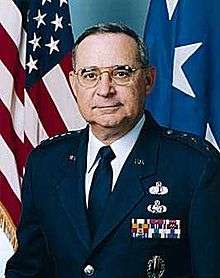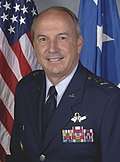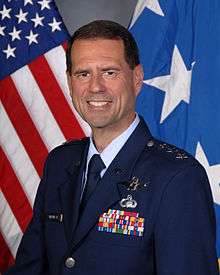Space and Missile Systems Center
The Space and Missile Systems Center (SMC) is a center of the United States Space Force and headquartered at Los Angeles Air Force Base (LAAFB), California. The Space and Missile Systems Center is responsible for developing, acquiring, fielding, and sustaining military space systems.
| Space and Missile Systems Center | |
|---|---|
 Space and Missile Systems Center shield | |
| Founded | 1 July 1954; 66 years, 1 month |
| Country | |
| Branch | |
| Role | Space research and development |
| Size | 6,300[1] |
| Headquarters | Los Angeles Air Force Base, California, U.S. |
| Decorations | Air Force Organization Excellence Award[2] |
| Website | http://www.losangeles.af.mil |
| Commanders | |
| Commander | |
| Vice Commander | |
| Command Chief | CCM Lisa R. Arnold |
Structure







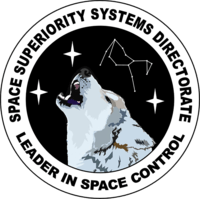





History
Western Development Division (1954–1957)

The Western Development Division (WDD) was established on 1 July 1954 by Brigadier General Bernard Schriever. Organized as a component of the United States Air Force's Air Research and Development Command, the Western Development Division's was stood up to accelerate the development of the SM-65 Atlas intercontinental ballistic missile (ICBM). Later in the year the Division gained responsibility for the development of the HGM-25A Titan I, which was a backup to the Atlas. By the end of 1955, the Western Development Division added another missile system, developing the PGM-17 Thor intermediate-range ballistic missile (IRBM). These three missile systems would become known as "First-Generation Missiles". Throughout its missile development, the Western Development Division pioneered the use of concurrent development on the largest scale since its inception.[4][5]
On 10 October 1955, the Western Development Division also gained the military space mission, assuming responsibility for the Military Satellite System, better known as Weapon System 117L (WS 117L), from the Wright Air Development Center. WS 117L has a family of different subsystems, with the most important being a photographic reconnaissance payload and a missile warning payload.[6]
Air Force Ballistic Missile Division (1957–1961)
On 1 June 1957, the Western Development Division was redesignated as the Air Force Ballistic Missile Division (AFBMD). In September 1959, the Air Force Ballistic Missile Division gained responsibility for developing reconnaissance and surveillance satellites and launch vehicles. In March 1961 it assumed the Army's responsibility for communications satellite development and the Navy's responsibility for navigation satellite development.[7]
The launch of Sputnik 1 by the Soviet Union reemphasized missile development. By 1957 the Air Force Ballistic Missile Division began making significant progress in its missile programs, performing successful launches of the Atlas, Titan I, and Thor missiles, beginning to turn them over to operational Strategic Air Command units.[8] Many of the first generation ballistic missiles were modified to become the first space launch vehicles. Modified Thor and Atlas missiles would serve as the basis of many space launch vehicles, with modified versions used into the 1980s and 1990s. NASA's Project Mercury relied on the Air Force's Atlas rockets and the Delta series of rockets were developed from the Thor.[9]
By 1959 the WS 117L was split into three different programs. The photographic reconnaissance payload were spun off into the Discoverer program and Satellite and Missile Observation System (SAMOS), while the missile warning payload became the Missile Defense Alarm System (MIDAS). Discoverer, the public name for the joint Air Force–Central Intelligence Agency Corona program, took film images in space, then orbited the film canisters which were caught mid–air by aircraft. SAMOS was designed to collect both photographic and electronic intelligence, and then electronically transmit them to ground stations. Future reconnaissance spacecraft were managed and developed by the National Reconnaissance Office. MIDAS used an infrared sensor to detect intercontinental ballistic missile launches, however it never became operational and remained a research and development program. A fourth satellite program was started in 1960, when the Air Force Ballistic Missile Division, NASA, and the United States Atomic Energy Commission initiated a joint project to develop a space–based nuclear detonation detection system. Project Vela led to the development of the Vela Hotel satellite network, which first launched in 1963.[10]
The Pioneer program was the first military space mission to be launched and operated by the Air Force. Launched in 1958, Pioneer 0, Pioneer 1, and Pioneer 2 were all Air Force programs, with Pioneers 1 and 2 turned over to NASA. Pioneer 1 is considered to be the first deep space probe and transmitted back extensive information about the Van Allen radiation belt. Although the Boeing X-20 Dyna-Soar was under development at the Wright Air Development Center, the Titan IIIC launch vehicle was being developed by the Air Force Ballistic Missile Division.[11]
Space Systems Division (1961–1967)

In 1961, Air Research and Development Command was transformed into Air Force Systems Command, led by former Western Development Division commander General Bernard Schriever. Due to the rising importance of space, the AFBMO was split on 1 April 1961, with the space-side becoming the Space Systems Division (SSD) and the missile-side becoming the Ballistic Missile Division (BMD).
The Ballistic Missile Division began development on the second generation of ballistic missiles in the early 1960s. This second generation included the LGM-25C Titan II and LGM-30 Minuteman. These two missiles replaced the first-generation Atlas and Titan I ballistic missiles, and served as the cornerstone of U.S. nuclear forces. The Minuteman I was replaced several years later by the improved Minuteman II and III missiles.[12] The Space Systems Division developed a number of space launch systems based upon the Ballistic Missile Division's ICBMs. NASA's Project Gemini was launched on modified Titan launch vehicles.[13]
The Space Systems Division continued the current space programs started by the AFBMD and started several advanced programs. Starting in 1963 an operational infrared missile warning program was started. Serving as a following on to MIDAS, this program would eventually become the Defense Support Program (DSP). The SSD also began development of the Defense Meteorological Support Program (DMSP), a weather observation satellite constellation. DMSP was initially tasked to support the National Reconnaissance Office, however in 1965 became a program office under the Space Systems Division. The Space Systems Division also started the world's first operational military satellite constellation, developing the Initial Defense Communications Satellite Program (IDCSP) in 1962.[14]
The Space Systems Division was also responsible for the development of anti-satellite systems. The first anti-satellite program developed by the SSD was Program 437, which used modified Thor missiles tipped with nuclear warheads to destroy orbital targets. Air Defense Command gained responsibility for the operational employment of the weapons system, and the program was shut down in 1975. Program 437 was developed into Program 437AP, which replaced the nuclear payload with a photographic system designed to inspect targeted satellites.[15]
In addition to uncrewed military space systems, General Schriever made the Space Systems Division responsible for all crewed military spaceflight. This put the Manned Orbiting Laboratory (MOL) program, a crewed military space station, under its purview. The SSD also began development of the Titan IIIM, which was designed to be the launch vehicle for the MOL. The program itself was canceled in 1969.[16]
In 1965 Air Force satellite operations transitioned from the 6594th Test Group to the Space Systems Division's Air Force Satellite Control Facility. Space launches were also directly conducted by the Space Systems Division. Launches from Vandenberg Air Force Base were conducted by the 6595th Aerospace Test Wing, while launches from Cape Canaveral Air Force Station were conducted by the 6555th Aerospace Test Wing.[17]
Space and Missile Systems Organization (1967–1979)
On 1 July 1967, the Space Systems Division and Ballistic Missile Division were merged again to create economic efficiencies, becoming the Space and Missile Systems Organization (SAMSO).[18]
In 1970 the Space and Missile Systems Organization's space launch functions were reorganized, with the Space and Missile Test Center (SAMTEC) established to oversee space launches from both Vandenberg AFB and Cape Canaveral AFS, while also managing the Western Test Range. The 6595th Aerospace Test Wing was organized under SAMTEC, while the 6555th Aerospace Test Wing was reorganized as the 6555th Aerospace Test Group and subordinated to the 6595th Aerospace Test Wing. In 1977 SAMTEC assumed responsibility for managing the Eastern Test Range. The Space and Missile Test Center was reorganized again in 1979, being redesignated the Space and Missile Test Organization (SAMTO). Its field units were replaced as well, with the new Eastern Space and Missile Center (ESMO) and Western Space and Missile Center (WSMO) being responsible for launching and managing their respective ranges.[19]
In 1973 SAMSO began development of a new ballistic missile program, which would become the LGM-118 Peacekeeper intercontinental ballistic missile.[20] In the 1970s NASA began development of the Space Transportation System, better known as the Space Shuttle. SAMSO was involved in the Defense Department's efforts to utilize the shuttle program, building a launch and landing facility at Vandenberg Air Force Base that permitted polar launches and the Inertial Upper Stage that permitted the shuttle to launch payloads into higher altitudes.[21]
Even with the merger of space and missiles, SAMSO continued its space program. Starting in 1969, the Defense Satellite Communications System (DSCS) was initially conceived as a follow on to the IDCSP and was first launched in 1971. SAMSO also developed the Fleet Satellite Communications System for the Navy, which had the Air Force Satellite Communications System as an embedded payload. Communications satellites were also developed for U.S. allies, with Skynet developed for the British Armed Forces and a series of NATO communications satellites developed. Aside from communications satellites, SAMSO made the first push towards global navigation, starting development of the Global Positioning System (GPS) in 1973. This system built upon the past success of the Navy's Transit and Timation programs, as well as the Air Force's 621B technology program. Initially conceived as a purely military system, GPS later was opened to the wider civilian population.[22]
SAMSO began the development of a follow-on anti-satellite weapons system that did not use nuclear warheads. Project Spike involved placing an anti-satellite missile on a Convair F-106 Delta Dart, which would then destroy the spacecraft through kinetic impact. Project Spike never entered the development stage, but rather formed the groundwork for future air-launched anti-satellite missiles.[23]
Space Division (1979–1990)

On 1 October 1979, space and missile functions were split for a second time. SAMSO was split, with its space functions becoming Air Force System Command's Space Division and its ballistic missile functions becoming the Ballistic Missile Office (BMO). On 1 October 1982, Air Force Space Command was established to serve as an operational command for space and consolidate Air Force space operations, which were splintered across several different major commands. On 1 October 1987, the Space Division's Air Force Satellite Control Facility was inactivated, with its functions and personnel transferred to Air Force Space Commands operational wings. On 1 October 1989, the Space and Missile Test Organization was inactivated, leaving its launch wings as direct reporting units to the Space Division. While operational responsibilities were transitioned to Air Force Space Command, the Space Division centralized the service's space research and development. In October 1982, the Space Division's Air Force Space Technology Center (AFSTC) was established at Kirtland AFB, with the Air Force Weapons Laboratory, Air Force Geophysics Laboratory, and Air Force Rocket Propulsion Laboratory assigned to it.[24]
The Space Division began the development of the Military Strategic and Tactical Relay (Milstar) communications satellite constellation in 1982, which was designed specifically to support the National Command Authority.[25] The 1986 Challenger disaster illustrated some of the major dangers of using the Space Shuttle as the sole space launch system. The Development of the Titan IV space launch vehicle began in 1985 but gained new importance after the disaster. Development also started on the Delta II and Atlas II space launch vehicles, both derived from earlier ballistic missiles.[26]
The Space Division continued SAMSO's anti-satellite weapons research, developing the McDonnell Douglas F-15 Eagle launched ASM-135 ASAT, which used kinetic impact to destroy a target. It destroyed the Solwind satellite in a 13 December 1985 test. In the early stages of the Strategic Defense Initiative, the Space Division was involved in the Boost Surveillance and Tracking System, Space Surveillance and Tracking System, and the Space-Based Interceptor.[27]
The Ballistic Missile Office continued SAMSO's development of the Peacekeeper missile, performing extensive test launches. The missile forces were activated in 1983 under Strategic Air Command in. In 1986, development also started on the MGM-134 Midgetman, also known as the Small ICBM. The Small ICBM program was canceled in 1992 with the end of the Cold War.[28]
Space Systems Division (1990–1992)
On 15 March 1990 the Space Division was restored to its historic name, being redesignated as the Space Systems Division (SSD). The same change also affected its sister organization, with the Ballistic Missile Office being redesignated the Ballistic Missile Division (BMD).[29]
The transition of launch functions to Air Force Space Command began on 1 October 1990, with the Eastern Space and Missile Center and Western Space and Missile Center transitioned into the new command. The transfer of launch responsibility gradually occurred, starting with the Delta II and Atlas E launch, followed by the transfer of Atlas II, Titan II, and Titan IV launches. In December 1990 the Air Force Space Technology Center combined its subordinate laboratories and was renamed the Phillips Laboratory, named after former commander of Air Force Systems Command and the director of NASA's Apollo program General Samuel C. Phillips [30]
With the end of the Cold War Air Force investment in missiles dropped significantly, resulting in the Ballistic Missile Division being redesignated as the Ballistic Missile Organization (BMO) and subsumed into the Space Systems Division, merging space and missiles development under the same organization for the third time.[31]
Space and Missile Systems Center (1992–present)

In 1992, Air Force Systems Command was merged with Air Force Logistics Command to become Air Force Materiel Command, resulting in the Space Systems Division being redesgnated as the Space and Missile Systems Center (SMC). In September 1993, the Ballistic Missile Organization was inactvated, fully merging missile development into the Space and Missile Systems Center.[32]
In January 1993, Kirtland Air Force Base and its host wing, the 377th Air Base Wing, were transferred from Air Mobility Command to the Space and Missile Systems Center. Many of SMC's subordinate units were reorganized into the larger Air Force Materiel Command. The Phillips Laboratory became the Air Force Research Laboratory on 8 April 1997, while Kirtland AFB and the 377th Air Base Wing were transferred to the Air Armament Center on 1 October 1998.[33]
The Space and Missile Systems Center began development of a new generation of launch vehicles, with the Atlas III procured in 1999. The Evolved Expendable Launch Vehicle program was contracted in 1995, resulting in the Delta IV and Atlas V space launch vehicles.[34]
With the completion of the GPS constellation in 1995 much of the center's space focus shifted to replacing aging spacecraft. In 1994, SMC began the development of the Space-Based Infrared System (SIBRS), a missile warning constellation that would serve as the successor of the Defense Support Program (DSP). Milstar also had a replacement system under works, with the Advanced Extremely High Frequency (AEHF) satellite communications constellation contracted in 1999. A year later, SMC issued a contract for the Wideband Global SATCOM (WGS) to replace the Defense Satellite Communications System (DSCS).[35]
Commissioned by congress, the Commission to Assess United States National Security Space Management and Organization was tasked to evaluate the status of the military and intelligence space forces of the United States. One of their key findings was that space operations and acquisitions should be centralized under one major command. As a direct result of the commissions recommendations, on 1 October 2001, the Space and Missile Systems Center was transferred from Air Force Materiel Command to Air Force Space Command.[36]
On 20 December 2019, the Space and Missile Systems Center, along with the rest of Air Force Space Command, became a component of the United States Space Force.[37]
Commanders
Commander, Western Development Division
| No. | Commander[38] | Term | Vice commander | |||
|---|---|---|---|---|---|---|
| Portrait | Name | Took office | Left office | Duration | ||
| 1 | Major General Bernard A. Schriever | 2 August 1954 | 31 May 1957 | 2 years, 302 days | Brigadier General Osmond J. Ritland | |
Commander, Air Force Ballistic Missile Division
| No. | Commander[38] | Term | |||
|---|---|---|---|---|---|
| Portrait | Name | Took office | Left office | Duration | |
| 1 | Major General Bernard A. Schriever | 1 June 1957 | 24 April 1959 | 1 year, 327 days | |
| 2 | Major General Osmond J. Ritland | 25 April 1959 | 31 March 1961 | 1 year, 340 days | |
Space Division and Ballistic Missile Office
Deputy Commander for Aerospace Systems, Air Force Systems Command
| No. | Commander[38] | Term | |||
|---|---|---|---|---|---|
| Portrait | Name | Took office | Left office | Duration | |
| 1 | Lieutenant General Howell M. Estes Jr. | 1 April 1961 | 10 October 1962 | 1 year, 192 days | |
Commander, Space Systems Division
| No. | Commander[38] | Term | |||
|---|---|---|---|---|---|
| Portrait | Name | Took office | Left office | Duration | |
| 1 | Major General Osmond J. Ritland | 1 April 1961 | 13 May 1962 | 1 year, 42 days | |
| 2 | Lieutenant General Howell M. Estes Jr. | 14 May 1962 | 2 October 1962 | 141 days | |
| 3 | Major General Ben I. Funk | 3 October 1962 | 31 August 1966 | 3 years, 332 days | |
| 4 | Major General Paul T. Cooper | 1 September 1966 | 30 June 1967 | 302 days | |
Commander, Ballistic Systems Division
| No. | Commander[38] | Term | |||
|---|---|---|---|---|---|
| Portrait | Name | Took office | Left office | Duration | |
| 1 | Major General Thomas P. Gerrity | 1 April 1961 | 30 June 1962 | 1 year, 90 days | |
| 2 | Major General W. Austin Davis | 1 July 1962 | 18 July 1964 | 2 years, 17 days | |
| 3 | Major General Harry J. Sands Jr. | 19 July 1964 | 19 July 1966 | 2 years, 0 days | |
| 4 | Major General John L. McCoy | 20 July 1966 | 30 June 1967 | 345 days | |
Commander, Space and Missile Systems Organization
| No. | Commander[38] | Term | |||
|---|---|---|---|---|---|
| Portrait | Name | Took office | Left office | Duration | |
| 1 | Lieutenant General John W. O'Neill | 1 July 1967 | 31 August 1969 | 2 years, 61 days | |
| 2 | Lieutenant General Samuel C. Phillips | 1 September 1969 | 24 August 1972 | 2 years, 358 days | |
| 3 | Lieutenant General Kenneth W. Schultz | 25 August 1972 | 28 August 1975 | 3 years, 3 days | |
| 4 | Lieutenant General Thomas W. Morgan | 29 August 1975 | 28 April 1978 | 2 years, 242 days | |
| 5 | Lieutenant General Richard C. Henry | 28 April 1978 | 30 September 1979 | 1 year, 155 days | |
Space Division and Ballistic Missile Office
Commander, Space Division
| No. | Commander[38] | Term | |||
|---|---|---|---|---|---|
| Portrait | Name | Took office | Left office | Duration | |
| 1 | Lieutenant General Richard C. Henry | 1 October 1979 | 1 May 1983 | 3 years, 212 days | |
| 2 | Lieutenant General Forrest S. McCartney | 1 May 1983 | 30 September 1986 | 3 years, 152 days | |
| 3 | Lieutenant General Aloysius G. Casey | 9 October 1986 | 23 June 1988 | 1 year, 258 days | |
| 4 | Lieutenant General Donald L Cromer | 24 June 1988 | 14 March 1989 | 263 days | |
Commander, Ballistic Missile Division
| No. | Commander[38] | Term | |||
|---|---|---|---|---|---|
| Portrait | Name | Took office | Left office | Duration | |
| 1 | Major General John W. Hepfer | 1 October 1979 | 31 October 1980 | 1 year, 30 days | |
| 2 | Major General Forrest S. McCartney | 31 October 1980 | 19 May 1982 | 1 year, 200 days | |
| 3 | Major General Aloysius G. Casey | 19 May 1982 | 30 September 1986 | 4 years, 134 days | |
| 4 | Major General Edward P. Barry Jr. | 30 September 1986 | 14 March 1989 | 2 years, 165 days | |
Space Systems Division and Ballistic Systems Division
Commander, Space Systems Division
| No. | Commander[38] | Term | |||
|---|---|---|---|---|---|
| Portrait | Name | Took office | Left office | Duration | |
| 1 | Lieutenant General Donald L. Cromer | 15 March 1989 | 31 May 1989 | 2 years, 77 days | |
| 2 | Lieutenant General Edward P. Barry Jr. | 8 July 1991 | 30 June 1992 | 358 days | |
Commander, Ballistic Systems Division
| No. | Commander[38] | Term | |||
|---|---|---|---|---|---|
| Portrait | Name | Took office | Left office | Duration | |
| 1 | Major General Edward P. Barry Jr. | 15 March 1989 | 30 May 1989 | 76 days | |
| 2 | Brigadier General Ralph G. Tourino | 30 May 1989 | 4 May 1990 | 339 days | |
Commander, Space and Missile Systems Center
| No. | Commander[38] | Term | Vice commander | Command chief | |||
|---|---|---|---|---|---|---|---|
| Portrait | Name | Took office | Left office | Duration | |||
| 1 | Lieutenant General Edward P. Barry Jr. | 1 July 1992 | 16 November 1994 | 2 years, 138 days | |||
| 2 | Lieutenant General Lester L. Lyles | 17 November 1994 | 18 August 1996 | 1 year, 275 days | |||
| 3 | Lieutenant General Roger G. DeKok | 19 August 1996 | 12 August 1998 | 1 year, 358 days | |||
| 4 | Lieutenant General Eugene L. Tattini | 13 August 1998 | 25 May 2001 | 2 years, 285 days | |||
| 5 | Lieutenant General Brian A. Arnold | 25 May 2001 | 20 May 2005 | 6 years, 280 days | |||
| 6 | Lieutenant General Michael A. Hamel | 20 May 2005 | 16 May 2008 | 2 years, 362 days | Brigadier General Ellen M. Pawlikowski (July 2007-May 2008) | ||
| 7 | Lieutenant General John T. Sheridan | 16 May 2008 | 3 June 2011 | 3 years, 18 days | Major General Samuel A. Greaves (August 2009-February 2011) | ||
| 8 | Lieutenant General Ellen M. Pawlikowski | 3 June 2011 | 19 June 2014 | 3 years, 16 days | Brigadier General Roger W. Teague (June 2011–August 2012) Major General Terrence A. Feehan (August 2012-June 2014) | ||
| 9 | Lieutenant General Samuel A. Greaves | 19 June 2014 | 22 March 2017 | 2 years, 276 days | Major General Robert D. McMurry Jr. (May 2014-May 2016) | Chief Master Sergeant Angelica Johnson Chief Master Sergeant Craig Hall | |
| 10 | Lieutenant General John F. Thompson | 22 March 2017 | Incumbent | 3 years, 146 days | Brigadier General Mark A. Baird (April 2016-June 2017) Brigadier General Philip A. Garrant (June 2017-June 2019) Brigadier General Donna D. Shipton (June 2019-June 2020) Brigadier General D. Jason Cothern (June 2020-present) | Chief Master Sergeant Scott Myers Chief Master Sergeant Lisa R. Arnold (January 2019-present) | |
References
- https://www.losangeles.af.mil/About-Us/Fact-Sheets/Article/343702/space-and-missile-systems-center/
- https://www.afhra.af.mil/About-Us/Fact-Sheets/Display/Article/432217/space-and-missile-systems-center-afspc/
- https://www.losangeles.af.mil/About-Us/Biographies/
- https://www.losangeles.af.mil/Portals/16/documents/AFD-060912-023.pdf?ver=2016-05-02-112845-400
- https://www.losangeles.af.mil/Portals/16/documents/AFD-060912-021.pdf?ver=2016-05-02-112844-290
- https://www.losangeles.af.mil/Portals/16/documents/AFD-060912-025.pdf?ver=2016-05-02-112847-777
- https://www.losangeles.af.mil/Portals/16/documents/AFD-060912-021.pdf?ver=2016-05-02-112844-290
- https://www.losangeles.af.mil/Portals/16/documents/AFD-060912-023.pdf?ver=2016-05-02-112845-400
- https://www.losangeles.af.mil/Portals/16/documents/AFD-060912-024.pdf?ver=2016-05-02-112840-947
- https://www.losangeles.af.mil/Portals/16/documents/AFD-060912-025.pdf?ver=2016-05-02-112847-777
- https://www.losangeles.af.mil/Portals/16/documents/AFD-060912-028.pdf?ver=2016-05-02-112846-557
- https://www.losangeles.af.mil/Portals/16/documents/AFD-060912-023.pdf?ver=2016-05-02-112845-400
- https://www.losangeles.af.mil/Portals/16/documents/AFD-060912-024.pdf?ver=2016-05-02-112840-947
- https://www.losangeles.af.mil/Portals/16/documents/AFD-060912-025.pdf?ver=2016-05-02-112847-777
- https://www.losangeles.af.mil/Portals/16/documents/AFD-060912-028.pdf?ver=2016-05-02-112846-557
- https://www.losangeles.af.mil/Portals/16/documents/AFD-060912-028.pdf?ver=2016-05-02-112846-557
- https://www.losangeles.af.mil/Portals/16/documents/AFD-060912-021.pdf?ver=2016-05-02-112844-290
- https://www.losangeles.af.mil/Portals/16/documents/AFD-060912-021.pdf?ver=2016-05-02-112844-290
- https://www.losangeles.af.mil/Portals/16/documents/AFD-060912-021.pdf?ver=2016-05-02-112844-290
- https://www.losangeles.af.mil/Portals/16/documents/AFD-060912-023.pdf?ver=2016-05-02-112845-400
- https://www.losangeles.af.mil/Portals/16/documents/AFD-060912-024.pdf?ver=2016-05-02-112840-947
- https://www.losangeles.af.mil/Portals/16/documents/AFD-060912-025.pdf?ver=2016-05-02-112847-777
- https://www.losangeles.af.mil/Portals/16/documents/AFD-060912-028.pdf?ver=2016-05-02-112846-557
- https://www.losangeles.af.mil/Portals/16/documents/AFD-060912-021.pdf?ver=2016-05-02-112844-290
- https://www.losangeles.af.mil/Portals/16/documents/AFD-060912-025.pdf?ver=2016-05-02-112847-777
- https://www.losangeles.af.mil/Portals/16/documents/AFD-060912-024.pdf?ver=2016-05-02-112840-947
- https://www.losangeles.af.mil/Portals/16/documents/AFD-060912-028.pdf?ver=2016-05-02-112846-557
- https://www.losangeles.af.mil/Portals/16/documents/AFD-060912-023.pdf?ver=2016-05-02-112845-400
- https://www.losangeles.af.mil/Portals/16/documents/AFD-060912-021.pdf?ver=2016-05-02-112844-290
- https://www.losangeles.af.mil/Portals/16/documents/AFD-060912-021.pdf?ver=2016-05-02-112844-290
- https://www.losangeles.af.mil/Portals/16/documents/AFD-060912-021.pdf?ver=2016-05-02-112844-290
- https://www.losangeles.af.mil/Portals/16/documents/AFD-060912-021.pdf?ver=2016-05-02-112844-290
- https://www.losangeles.af.mil/Portals/16/documents/AFD-060912-021.pdf?ver=2016-05-02-112844-290
- https://www.losangeles.af.mil/Portals/16/documents/AFD-060912-024.pdf?ver=2016-05-02-112840-947
- https://www.losangeles.af.mil/Portals/16/documents/AFD-060912-025.pdf?ver=2016-05-02-112847-777
- https://www.losangeles.af.mil/Portals/16/documents/AFD-060912-021.pdf?ver=2016-05-02-112844-290
- https://www.losangeles.af.mil/Units/
- https://www.losangeles.af.mil/Portals/16/documents/AFD-120802-071.pdf?ver=2016-05-02-112851-807
![]()
